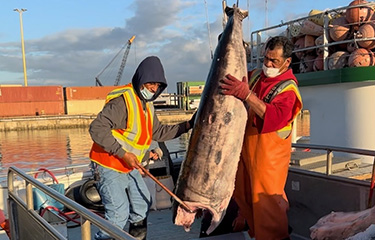The Hawaiian swordfish longline fleet’s first season since it achieved Marine Stewardship Council certification in September 2022 “is in full swing,” according to the Hawaii Longline Association (HLA).
The Hawaii longline shallow-set swordfish season runs from January until June, primarily in international waters around the Hawaii Archipelago, supplying fresh, ice-chilled fish to Hawaii and U.S. mainland markets.
“Hawaii-landed swordfish has always been a high-quality option for seafood lovers,” United Fishing Agency Auction Manager Mike Goto said in a press release. “The landed quality and size of fish, as well as the diverse culinary preparations for swordfish, really make it a premium seafood product.”
Hawaii’s longline fleet is comprised of 150 vessels, with most targeting bigeye and yellowfin tuna year-round. Around 20 vessels out of the fleet seasonally fish for swordfish in waters approximately 1,000 nautical miles north of Honolulu, according to the HLA. The fleet annually catches around 1.5 million pounds of swordfish, accounting for 50 percent of total domestic swordfish landings, making the Hawaii fishery the largest domestic swordfish producer to the U.S. market.
“The fishery is among the most highly monitored and strictly regulated fisheries on Earth,” Hawaii Longline Association Executive Director Eric Kingma said. “We have 100 percent federal observer coverage, satellite-based vessel monitoring, daily at-sea electronic reporting, and other requirements including protected species mitigation measures. With our recent MSC certification, consumers can be more confident than ever that the Hawaii swordfish they enjoy is harvested in a responsible and sustainable manner.”
In separate news, NOAA has rejected a proposal that would have allowed Native Hawaiian subsistence fishermen to sell some of their catch to recoup costs for fishing in the Papahānaumokuākea Marine National Monument.
Created in 2006 and expanded in 2016, the monument and the Southern Exclusion Zone together prohibit fishing in 80 percent of the U.S. exclusive economic zone around Hawaii.
In December 2022, the Western Pacific Regional Fishery Management Council (Wespac) passed a proposal to allow Native Hawaiian subsistence fishermen to sell some of their catch, up to the value of bait, fuel, and ice used in their trip to the monument. But in a 22 February letter sent to Wespac, NOAA Assistant Administrator Nicole LeBoeuf said the proposal conflicts with the National Marine Sanctuaries Act.
LeBoeuf said fishing in the monument “must be sustainable and must not serve as a toehold for prohibited commercial fishing.”
The proposal would have allowed for Native Hawaiians with subsistence fishing permits could catch up to 350,000 pounds of certain fish and recoup up to USD 15,000 (EUR 14,000) in costs per trip.
But LeBoeuf said opening up commercial activity in the monument ...
Photo courtesy of Hawaii Longline Association








